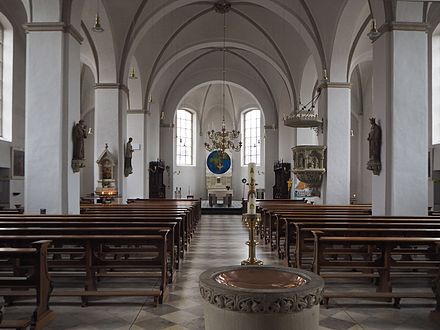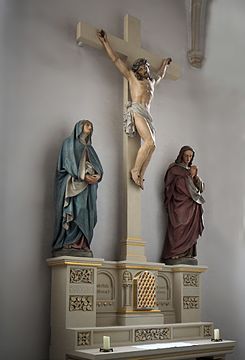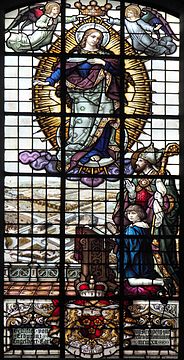St. Mauritius (Nordkirchen)
The Catholic parish church of St. Mauritius is in the center of the Münsterland town of Nordkirchen .
Construction and building history
The church was built from 1715 by Gottfried Laurenz Pictorius as a baroque hall church. It has a recessed choir with a polygonal finish. The building is structured to the outside by segmented arched windows and buttresses. The integrated tower towers over the place with its slate dome and the attached lantern . The dark red bricks of the tower contrast strikingly with the white plastered nave. The tower is clearly structured by intermediate paragraphs and decorated with white arches.
The entrance portal bears the alliance coat of arms of Plettenberg and Westerholt . The portal comes from Johann Hermann Anton Kocks and was probably built according to a design by Peter Pictorius the Elder. J. (1673–1735) designed, based on the window design of the Conservator's Palace in Rome .
The originally baroque, three-aisled interior of the church was rebuilt in 1884 in the neo-Romanesque style and equipped with a high altar and the two choir stalls. Cross-shaped pillars support a rib vault with arched belts.
Furnishing
- High Altar Crucifix
- The crucifixion scene is a plaster cast that was made in 1836. It is the cast of a cemetery crucifix from St. Hedwig's Cathedral in Berlin . The original was created by Theodor Wilhelm Achtermann in 1834 .
- Baptismal font
- The font originally dates from the 2nd quarter of the 13th century. At the top and bottom it shows a leaf frieze. Around 1900 the baptismal font was reworked, whereby it u. a. received a pedestal.
- Western side windows
- In contrast to the other plain windows, the western windows are lavishly designed. They were created in 1912, executed by Wilhelm Derix from Friedrich Stummel's cardboard boxes . They were donated by the Duke of Arenberg. On them, his two sons are shown, Princes Engelbert Carl and Erich von Arenberg. Bird's-eye views of Nordkirchen Castle appear in the background. They show the castle as it was in 1702 and 1912.
organ
The organ of St. Mauritius was built in 1986 by the organ building company Fleiter (Münster), whereby 8 stops were taken from the previous organ . The instrument has abrasive loading, Spieltrakturen are mechanically, the Registertrakturen electrically.
|
|
|
||||||||||||||||||||||||||||||||||||||||||||||||||||||||||||||||||||||||||||||||||||||||||||||||
- Coupling : II / I, I / P, II / P
- Annotation:
- H = stops from the previous organ
Bells
In the west tower there is a five-part bronze bell with the tone sequence des'-f'-as'-as'-b '. One of the as' bells dates from the 13th century and is usually not rung in the plenary. The bells of the ', f' and b 'come from Petit & Gebr. Edelbrock in Gescher. The f'-bell from 1857, the b'-bell from 1937 and the large bell from 1951. The younger a'-bell is from 1731.
Church square development
Several historical buildings connected to St. Mauritius have been preserved on the church square:
- the former Küsterei, (Mauritiusplatz 4), built by Johann Conrad Schlaun in 1733/34
- the former poor house (Mauritiusplatz 6), also built by Schlaun in 1730–33
- the former Vikarie (Mauritiusplatz 7), half-timbered house from 1675
literature
- Karl E. Mummenhoff: Nordkirchen Castle (Westphalian art). Munich / Berlin 1975, ISBN 3-422-00115-8
- Georg Dehio: Handbook of German Art Monuments,
North Rhine-Westphalia II - Westphalia
Revised Edition 2016, ISBN 978-3-422-03114-2
Web links
Individual evidence
- ^ Georg Dehio: Handbook of German Art Monuments, North Rhine-Westphalia II (2016), p. 798
Coordinates: 51 ° 44 ′ 19.1 ″ N , 7 ° 31 ′ 33.2 ″ E











